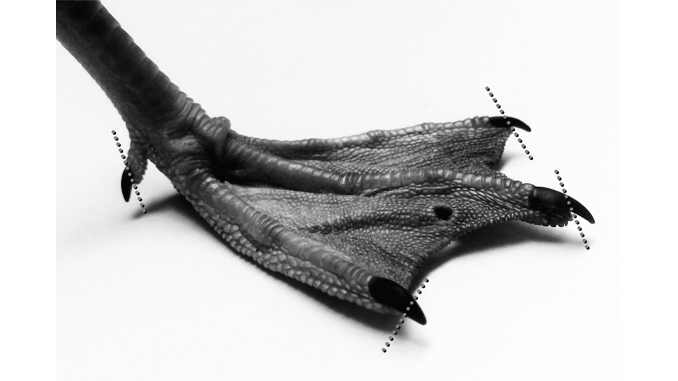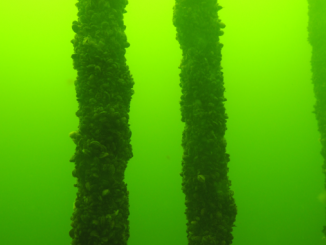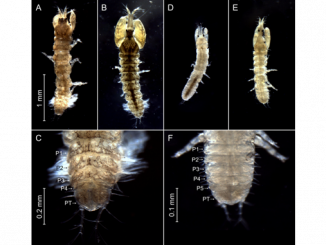
Paper category: Original research paper
Corresponding author: Agnieszka Grajewska (oceagr@ug.edu.pl)
DOI: 10.2478/ohs-2019-0015
Received: 09/07/2018
Accepted: 19/09/2018
Full text: here
Citation (APA style): Grajewska, A., Falkowska, L. & Reindl, A. (2019). Evaluation of claws as an alternative route of mercury elimination from the herring gull (Larus argentatus). Oceanological and Hydrobiological Studies, 48(2), pp. 165-173. Retrieved 3 Oct. 2019, from doi:10.1515/ohs-2019-0015
Abstract
Mercury enters the body of seabirds in its most toxic organic form, i.e. methylmercury, mainly via the alimentary tract. Inside the body, mercury is transformed into less toxic forms and accumulates in the internal organs. The process of mercury removal from the body, most effective during the formation of new feathers and claws, is beneficial for the bird. The presented research was undertaken on account of the high affinity of mercury to keratin – a protein that forms feathers and claws – to compare the concentration levels (HgTOT) in these structures and to assess their contribution to the purification of the body of herring gulls (Larus argentatus). Bird feathers are the only epidermal structure that is extensively described in the literature, whereas the claws have so far been poorly researched.
The study has shown that mercury in claws is built in as effectively as in feathers, and the obtained concentrations were within a wide range of 127.2–5341.5 ng HgTOT g-1 of dry weight. In addition, the concentrations of total mercury accumulated in the claws were a better reflection of Hg levels in internal organs compared to feathers.
Agnieszka Grajewska
Lucyna Falkowska
Andrzej Reindl
References
Ackerman, J.T., Eagels-Smith, C.A. Herzog, M.P., Hartman C.A., Peterson, S.H. et al. (2016). Avian mercury exposure and toxicological risk across western North America: A synthesis. Science of the Total Environment 568: 749–769.
Bearhop, S., Furness, R.W., Hilton, G.M., Votier, S.C. & Waldron, S. (2003). A forensic approach to understanding diet and habitat use from stable isotope analysis of (avian) claw material. Funct. Ecol. 17: 270–275.
Becker, P.H. (1992). Egg mercury levels decline with the laying sequence in charadriiformes. Bull. Environ. Contam. Toxicol. 48: 762–767.
Bełdowska, M. (2016). The direction of changes in the circulation of mercury in the coastal zone of southern Baltic against weather anomalies. In L. Falkowska (Ed.), Rtęć w Srodowisku – Identyfikacja zagrożeń dla zdrowia człowieka (pp. 39–42). Gdańsk: Wydawnictwo Uniwersytetu Gdańskiego. (In Polish).
Blum, J.D., Popp, B.N., Drazen, J.C., Choy, C.A. & Johnson, M.W. (2013) Methylmercury production below the mixed layer in the North Pacific Ocean. Nat. Geosci. 6: 879–884. DOI: 10.1038/ngeo1918.
Bond, A.L. & Diamond, A.W. (2009). Total and methyl mercury contaminations in seabird feathers and eggs. Arch. Environ. Contam. Toxicol. 56: 286–291.
Braune, B.M. & Gaskin, D.E. (1987). Mercury levels in Bonaparte’s gulls (Larus philadelphia) during autumn molt in the Quoddy region, New Brunswick, Canada. Arch. Environ. Contam. Toxicol. 16: 539–549.
Burger, J. & Gochfeld, M. (1997). Risk, Mercury levels, and birds: relating adverse laboratory effects to field biomonitoring. Environmental Research 75: 160–172.
Burger, J. & Gochfeld, M. (2002). Effects on chemicals and pollution in seabirds. In E.A. Schreiber & J. Burger (Eds.), Biology of marine birds (pp. 484–525). New York: CRC Press.
Burgess, N.M., Bond, A.L., Herbert, C.E., Neugebauer, E. & Champoux, L. (2013). Mercury trends in herring gull (Larus argentatus) eggs from Atlantic Canada 1972–2008: temporal change or dietary shift? Environ. Pollut. 172: 216–222.
Cossa, D. & Martin, J.M. (1991). Mercury in the Rhone delta and adjacent marine areas. Marine Chemistry 36: 291–302.
Dauwe, T., Bervoets, L., Pinxten, R., Blust, R. & Eens, M. (2003). Variation of heavy metals within and among feathers of birds of prey: effects of molt and external contamination. Environ. Pollut. 124: 429–436.
Ethier, D.M., Kyle, C.J., Kyser, T.K. & Nocera, J.J. (2010). Variability in the growth patterns of the cornified claw sheath among vertebrates: implications for using biogeochemistry to study animal movement. Can. J. Zool. 88: 1043–1051.
Falkowska, L., Grajewska, A., Staniszewska, M., Nehring, I., Szumiło-Pilarska, E. et al. (2017). Inhalation – Route of EDC exposure in seabirds (Larus argentatus) from the Southern Baltic. Marine Pollution Bulletin 117(1–2): 111–117.
Falkowska, L., Reindl, A.R., Grajewska, A. & Lewandowska, A.U. (2016). Organochlorine contaminants in the muscle, liver and brain of seabirds (Larus) from the coastal area of the Southern Baltic. Ecotoxicology and Environmental Safety 133: 63–72. DOI: 10.1016/j.ecoenv.2016.06.042.
Falkowska, L., Reindl, A.R., Szumiło, E., Kwaśniak, J., Staniszewska, M. et al. (2013). Mercury and chlorinated pesticides on the highest level of the food web as exemplified by herring from the Southern Baltic and African penguins from zoo. Water, Air, and Soil Pollution 224: 1549–1563.
Fitzgerald, W.F., Lamborg, C.H. & Hammerschmidt, C.R. (2007). Marine biogeochemical cycling of mercury. Chem. Rev. 107: 641–662. DOI: 10.1021/cr050353m.
Fridolfsson, A.K. & Ellegren, H. (1999). A simple and universal method for molecular sexing of non-ratite birds. Journal of Avian Biology 20: 116–121.
Furness, R.W. & Camphuysen, K.C. (1997). Seabirds as monitors of the marine environment. ICES Journal of Marine Science 54: 726–737.
Georgescu, B., Carmen Georgescu, C., Stelian Dărăban, S., Bouaru, A. & Paşcalău, S., (2011). Heavy Metals Acting as Endocrine Disrupters. Scientific Papers: Animal Science and Biotechnologies 44(2): 89–93.
Goede, A.A. & de Bruin, M. (1984). The use of bird feather parts as a monitor for metal pollution. Environmental Pollution Series B, Chemical and Physical 8(4): 281–298.
Grajewska, A., Falkowska, L., Szumiło-Pilarska, E., Hajdrych, J., Szubska, M. et al. (2015). Mercury in the eggs of aquatic birds from the Gulf of Gdansk and Wloclawek Dam (Poland). Environ. Sci. Pollut. Res. 22(13): 9889–9898.
Hahn, S., Dimitrov, D., Rehse, S., Yohannes, E. & Jenni, L. (2014). Avian claw morphometry and growth determine the temporal pattern of archived stable isotopes. Journal of Avian Biology 45: 202–207.
HELCOM (2010) Hazardous substances in the Baltic Sea – an integrated thematic assessment of hazardous substances in the Baltic Sea. Baltic Sea Environ. Proc. No. 120B. Helsinki Commission, Helsinki, Finland, 116 pp.
Hoefer, H.L. (2012). Grooming in Pets. Compendium: Continuing Education for Veterinarians Retrieved from http://vetfolio-vetstreet.s3.amazonaws.com/94/d714c078db11e1806d005056ad4734/file/PV0412_Hoefer-2%203-13.pdf.
Kahle, S. & Becker, P.H. (1999). Bird blood as an indicatorfor mercury in the Environment. Chemosphere 39: 2451–2457.
Kalisinska, E. & Dziubak, K. (2007). Rtęć u gągoła Bucephala clangula z Zalewu Szczecińskiego. Ochr. Środ. Zas. Nat. 31: 404–409. (In Polish).
Kim, E.Y., Murakami, T., Saeki, K. & Tatsukawa, R. (1996). Mercury levels and its chemical form in tissues and organs of seabirds. Arch. Environ. Contam. Toxicol. 30: 259–266.
Kojadinovic, J., Bustamante, P., Churlaud, C., Cosson, R.P. & Le Corre, M. (2007). Mercury in seabird feathers: insight on dietary habits and evidence for exposure levels in the western Indian Ocean. Sci. Total Environ. 384(1–3): 194–204.
Kruszewicz, A.G. (2011). Ptaki Polski od A do Ż. Warszawa, Multico Oficyna Wydawnicza. (In Polish).
Lucas, A.M. & Stettenheim, P.R. (1972). Avian anatomy. Integument. Washington, D.C., U.S. Deptartment of Agriculture.
Malling Olsen, K. & Larsson, H. (2004). Gulls of Europe, Asia and North America. Christopher Helm, London 65(83): 128–141, 254–278, 438–452.
Mallory, M.L., Robinson, S.A., Hebert, C.E. & Forbes, M.R. (2010). Seabirds as indicators of aquatic ecosystem conditions: a case for gathering multiple proxies of seabird health. Marine Pollution Bulletin 60: 7–12.
Meissner, W. Staniszewska, J. & Bzoma, S. (2007). Abundance, species composition and age structure of gulls Laridae in the Gulf of Gdańsk area during non-breeding season. Ornithological Notes 48: 67–81.
Monteiro, L.R. & Furness, R.W. (1995). Seabirds as monitors of mercury in the marine Environment. Water, Air, and Soil Pollution 80: 851–870.
Poulin, J. & Gibb, H. (2008) Mercury: Assessing the environmental burden of disease at national and local levels. In A. Prüss-Üstün (Ed.) World Health Organization, Geneva, 2008. (WHO Environmental Burden of Disease Series No. 16).
Reindl, A.R., Falkowska, L. & Grajewska, A. (2015). Chlorinated herbicides in fish, birds and mammals in the Baltic Sea. Water, Air, and Soil Pollution 226: 276.
Rozporządzenie Ministra Środowiska z dnia 16 grudnia 2016 r. w sprawie ochrony gatunkowej zwierząt (Journal of Laws of 2016, Item 2183) (In Polish).
Saniewska, D., Bełdowska, M., Bełdowski, J., Saniewski, M. & Kwaśniak, J. (2010). Distribution of mercury in different environmetal compartments in the aquatic ecosystem of the coastal zone of the Southern Baltic Sea. Journal of Environmental Science 22(8): 1144–1150.
Savinov, V.D., Gabrielsen, M.G. & Savinova, T.W.N. (2003). Cadmium, zinc, copper, arsenic, selenium and mercury in seabirds from the Barents Sea: levels, inter-specific and geographical differences. Sci. Total Environ. 306: 133–158.
Scheuhammer, A.M, Meyer, M.W., Sandheinrich, M.B. & Murray, M.W. (2007). Effects of environmental methylmercury on the health of wild birds, mammals, and fish. AMBIO 36: 12–19. DOI: 10.1579/0044-7447(2007)36[12:EOEMOT]2.0.CO;2).
Stettenheim, P.R. (2000). The Integumentary Morphology of Modern Birds – An Overview. Integrative and Comparative Biology 40(1): 461–477.
Stewart, F.M., Phiilips, R.A., Catry, P. & Furness, R.W. (1997). Influence of species, age, and diet on mercury concentration in Shetland seabirds. Marine Ecology Progress Series 151: 237–244.
Szumiło, E., Szubska, M., Meissner, W., Bełdowska, M. & Falkowska, L. (2013). Mercury in immature and adults Herring Gulls (Larus argentatus) wintering on the Gulf of Gdansk area. Oceanological and Hydrobiological Studies 42(3): 260–267. DOI: 10.2478/s13545-013-0082-y.
Szumiło-Pilarska, E., Grajewska, A., Falkowska, L., Hajdrych, J., Meissner, W. et al. (2016). Species differences in total mercury concentration in gulls from the Gulf of Gdansk (Southern Baltic). J. Trace Elem. Med. Biol. 33: 100–109. DOI: 10.1016/j.jtemb.2015.09.005.
Szumiło-Pilarska, E., Falkowska, L., Grajewska, A. & Meissner, W. (2017). Mercury in feathers and blood of gulls from the Southern Baltic coast, Poland. Water, Air, and Soil Pollution 228: 138. DOI: 10.1007/s11270-017-3308-6.
Thompson, D.R., Hamer, K.C. & Furness, R.W. (1991). Mercury accumulation in great skuas Catharacta skua of known age and sex, and its effects upon breeding and survival. Journal of Applied Ecology 28: 672–684.
Thompson, D.R., Becker, P.H. & Furness, R.W. (1993). Long-term changes in mercury concentrations in herring gulls Larus argentatus and common terns Sterna hirundo from the German North Sea Coast. Journal of Applied Ecology 30: 316–320.
Thompson, D.R., Bearhop, S., Speakman, J.R. & Furness, R.W. (1998). Feathers as a means of monitoring mercury in seabirds: insights from stable isotope analysis. Environmental Pollution 101: 193–200.
WHO/IPCS. (1990). Environmental Health Criteria (EHC) 101: Methylmercury. Geneva: World Health Organization, International Programme on Chemical Safety.
Yin, X., Xia, L., Sun, L., Luo, H. & Wang, Y. (2008). Animal excrement: a potential biomonitor of heavy metal contamination in the marine environment. Sci. Total Environ. 399: 179–185.
Zamani-Ahmadmahmoodi, R., Alahverdi, M. & Mirzaei, R. (2014). Mercury concentrations in common tern Sterna hirundo and slender-billed gull Larus genei from the Shadegan Marshes of Iran, in north-western corner of the Persian Gulf. Biological Trace Element Research 159: 161–166.



Bądź pierwszy, który skomentuje ten wpis